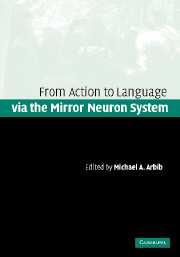Book contents
- Frontmatter
- Contents
- List of contributors
- Preface
- Part I Two perspectives
- Part II Brain, evolution, and comparative analysis
- Part III Dynamic systems in action and language
- Part IV From mirror system to syntax and Theory of Mind
- Part V Development of action and language
- 12 The development of grasping and the mirror system
- 13 Development of goal-directed imitation, object manipulation, and language in humans and robots
- 14 Assisted imitation: affordances, effectivities, and the mirror system in early language development
- 15 Implications of mirror neurons for the ontogeny and phylogeny of cultural processes: the examples of tools and language
- Index
13 - Development of goal-directed imitation, object manipulation, and language in humans and robots
Published online by Cambridge University Press: 01 September 2009
- Frontmatter
- Contents
- List of contributors
- Preface
- Part I Two perspectives
- Part II Brain, evolution, and comparative analysis
- Part III Dynamic systems in action and language
- Part IV From mirror system to syntax and Theory of Mind
- Part V Development of action and language
- 12 The development of grasping and the mirror system
- 13 Development of goal-directed imitation, object manipulation, and language in humans and robots
- 14 Assisted imitation: affordances, effectivities, and the mirror system in early language development
- 15 Implications of mirror neurons for the ontogeny and phylogeny of cultural processes: the examples of tools and language
- Index
Summary
Introduction
The aim of the present volume is to enrich human language dimensions by seeking to understand how the use of language may be situated with respect to other systems for action and perception. There is strong evidence that higher human cognitive functions, such as imitation and language, emerged from or co-evolved with the ability for compositionality of actions, already present in our ancestors (Rizzolatti and Arbib, 1998; Lieberman, 2000; Arbib, 2003; Arbib, Chapter 1, this volume). Corroborating evidence from psychology (Greenfield et al., 1972; Iverson and Thelen, 1999; Glenberg and Kaschak, 2002), neurobiology (Pulvermüller, 2003) and cognitive sciences (Siskind, 2001; Reilly, 2002) strongly support a close relationship between language, perception, and action. Social abilities, such as imitation, turn-taking, joint attention and intended body communication, are fundamental for the development of language and human cognition. Together with the capacity for symbolization, they form the basis of language readiness (Rizzolatti and Arbib, 1998; Arbib, 2003).
The work presented in this chapter takes inspiration from this body of experimental evidence in building a composite model of the human's cognitive correlates to action, imitation and language. The model will contribute to develop a better understanding of the common mechanisms underlying the development of these skills in human infants, and will set the stage for reproducing these in robots and simulated agents.
A recent trend of robotics research follows such views, by equipping artifacts with social capabilities.
- Type
- Chapter
- Information
- Action to Language via the Mirror Neuron System , pp. 424 - 468Publisher: Cambridge University PressPrint publication year: 2006
- 2
- Cited by



